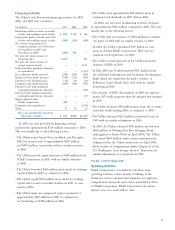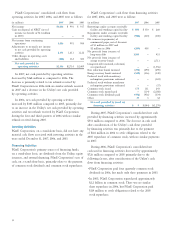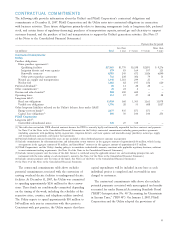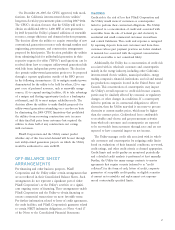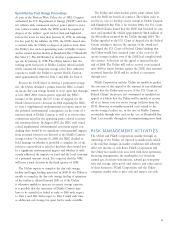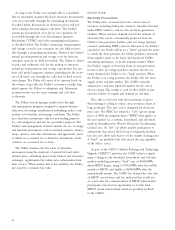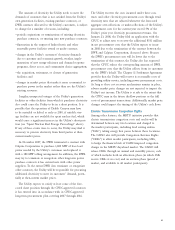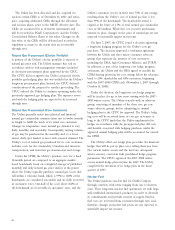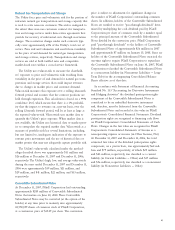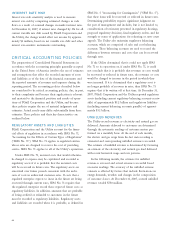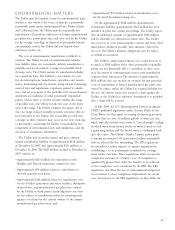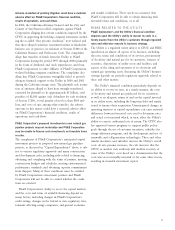PG&E 2007 Annual Report Download - page 63
Download and view the complete annual report
Please find page 63 of the 2007 PG&E annual report below. You can navigate through the pages in the report by either clicking on the pages listed below, or by using the keyword search tool below to find specific information within the annual report.61
The amount of electricity the Utility needs to meet the
demands of customers that is not satisfi ed from the Utility’s
own generation facilities, existing purchase contracts, or
DWR contracts allocated to the Utility’s customers, is subject
to change for a number of reasons, including:
• periodic expirations or terminations of existing electricity
purchase contracts, or entering into new purchase contracts;
• fl uctuation in the output of hydroelectric and other
renewable power facilities owned or under contract;
• changes in the Utility’s customers’ electricity demands
due to customer and economic growth, weather, imple-
mentation of new energy effi ciency and demand response
programs, direct access, and community choice aggregation;
• the acquisition, retirement, or closure of generation
facilities; and
• changes in market prices that make it more economical to
purchase power in the market rather than use the Utility’s
existing resources.
Lengthy, unexpected outages of the Utility’s generation
facilities or other facilities from which it purchases electricity
also could cause the Utility to be in a short position. It is
possible that the operation of Diablo Canyon may have
to be curtailed or halted as early as 2010, if suitable stor-
age facilities are not available for spent nuclear fuel, which
would cause a signifi cant increase in the Utility’s short posi-
tion (see “Spent Nuclear Fuel Storage Proceedings” above).
If any of these events were to occur, the Utility may fi nd it
necessary to procure electricity from third parties at then-
current market prices.
In December 2007, the DWR terminated a contract with
Calpine Corporation to purchase 1,000 MW of base load
power needed by the Utility’s customers and replaced it
with a 180 MW tolling arrangement. In addition, the DWR
may try to terminate or renegotiate other long-term power
purchase contracts it has entered into with other power
suppliers. To the extent DWR does terminate or renegotiate
other contracts, the Utility will be responsible for procuring
additional electricity to meet its customers’ demand, poten-
tially at then-current market prices.
The Utility expects to satisfy at least some of the fore-
casted short position through the CPUC-approved contracts
it has entered into in accordance with its CPUC-approved
long-term procurement plan covering 2007 through 2016.
The Utility recovers the costs incurred under these con-
tracts and other electricity procurement costs through retail
electricity rates that are adjusted whenever the forecasted
aggregate over-collections or under-collections of the Utility’s
procurement costs for the current year exceed 5% of the
Utility’s prior year electricity procurement revenues. On
January 23, 2008, the Utility fi led an application with the
CPUC to adjust rates to recover the additional $531 million
in net procurement costs that the Utility expects to incur
in 2008 due to the termination of the contract between the
DWR and Calpine Corporation, discussed above. Because
the DWR’s procurement costs will be lower due to the
termination of this contract, the Utility also has requested
that the CPUC reduce the corresponding amount of DWR
procurement costs that the Utility collects from its customers
on the DWR’s behalf. The Chapter 11 Settlement Agreement
provides that the Utility will recover its reasonable costs of
providing utility service, including power procurement costs.
As long as these cost recovery mechanisms remain in place,
adverse market price changes are not expected to impact the
Utility’s net income. The Utility is at risk to the extent that
the CPUC may in the future disallow portions or the full
costs of procurement transactions. Additionally, market price
changes could impact the timing of the Utility’s cash fl ows.
Electric Transmission Congestion Rights
Among other features, the MRTU initiative provides that
electric transmission congestion costs and credits will be
determined between any two locations and charged to
the market participants, including load serving entities
(“LSEs”), taking energy that passes between those locations.
The CAISO also will provide Congestion Revenue Rights
(“CRRs”) to allow market participants, including LSEs,
to hedge the fi nancial risk of CAISO-imposed congestion
charges in the MRTU day-ahead market. The CAISO will
release CRRs through an annual and monthly process, each
of which includes both an allocation phase (in which LSEs
receive CRRs at no cost) and an auction phase (priced at
market, and available to all market participants).


